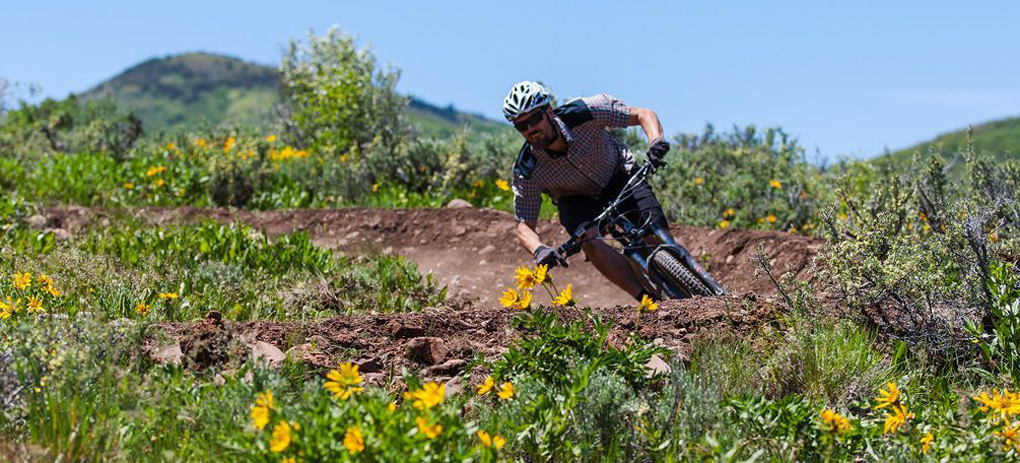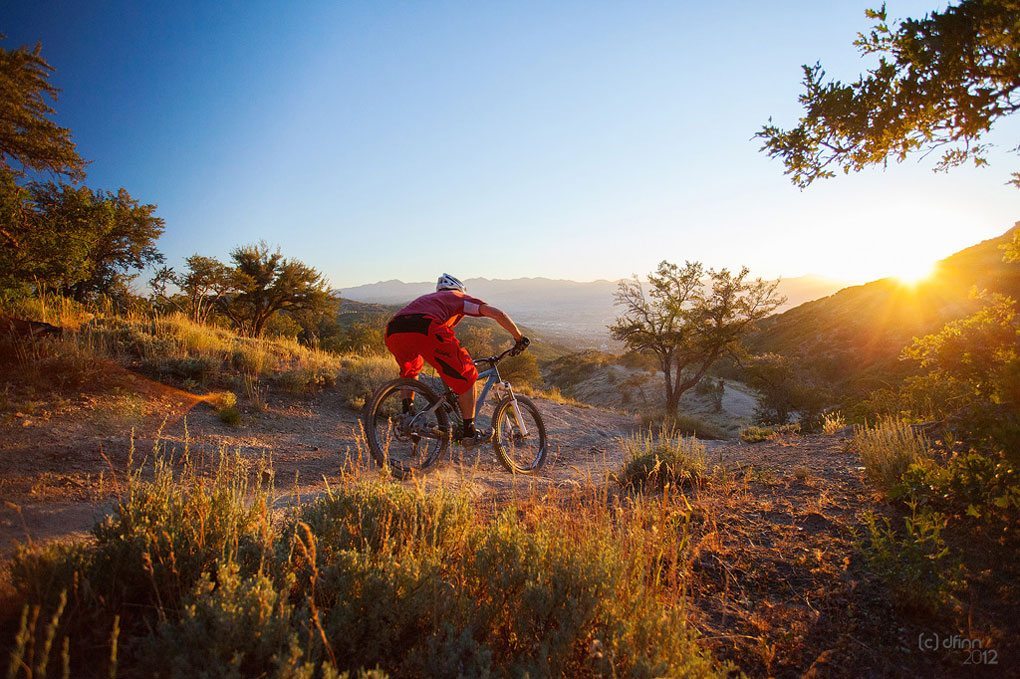Q: If you could have only one trail bike, would it be short travel or long travel? Why?
Noah: Long. A 160 mm travel bike is overkill for 90% of the trails I ride, but I still ride one a lot of the time, and for a few reasons:
- Longer travel bikes are lighter and more efficient than they’ve ever been, so the penalty associated with riding a longer travel bike isn’t nearly what it used to be.
- In a lot of situations on smoother trails, a longer travel bike is most likely slower. But I’m not racing much these days, and I don’t care. Even if they’re slower, big bikes are shitloads of fun.
- Even if a longer travel bike isn’t “necessary” or the fastest option on a given trail, that doesn’t mean they’re useless. It’s a rare trail I can’t ride on my hardtail (and have fun doing it), but that doesn’t mean I can’t have fun on a long travel bike. And while the climbs might suck a bit more, more travel means I can play around and take some of the more “creative” lines where that extra bit of travel might be useful to deal with the giant pile of high-speed gnar that that sort of creativity sometimes leads to.
- Even if most of the trails I ride don’t require long travel, those aren’t the trails I have in mind when I buy a bike. It’s just like with skis; my quiver-of-one would be relatively fat, because I’d rather rail groomers on wide skis than gape my way around powder on race sticks. I buy the bike for the trails I want to ride, so when I do get to ride them, I’m not pissed off I’m on some short travel wanker bike.
All that said, I’m not a one-bike-quiver kind of guy. I spend a lot of time on a 160mm travel bike, but I probably spend an equal amount of time on a 29er hardtail. And hardtails are easier to maintain, so there’s that.
Marshal: This season, I’m going to run 120 mm up front and 100 mm rear travel 29’er as a “quiver of one” bike, and will race it at a handful of enduro races, super d races, and xc races. Well actually, I’m going to combine it with a hardtail for when it’s rainy and I’m riding on sandy trails. Wet, fine sand trashes the pivot bearings on my full suspension bike.

I now live in a place where trails are significantly less technical than where I learned to ride (and rode for 15+ years) so I am now looking more for the bike to disappear than I am wanting a ton of suspension to serve as a crutch.
On the steepest, roughest, loosest trails in the Wasatch range, the 120/100 bike is faster (and at least to me, more fun—making somewhat pedestrian trails more exciting) than the 160 mm bike I am coming off of. And really, there is no downside unless the trail is super brake-bumped out.
Tom: I like longer travel bikes, but specifically ones with geometry that lends some nimbleness. My riding tends toward playful, but I like to be able to get a little stupid through rough sections in a way that only long-travel bikes allow. Long travel bikes can mute trail feel, but I find short chainstays can counter that some by quickening handling and making the bike more easily affected by rapid body position changes.
More travel lets a bike sink into a turn and then pop out of it in a way that is very similar to what a flexing ski accomplishes on snow when carving, and it feels awesome.
By always riding a longer-travel bike, I also never find myself passing up a challenging trail or feature and muttering the excuse: ‘I’m on the wrong bike.’

An often-made criticism is that long travel bikes climb poorly, but climbing performance never seems to suffer as much as people think it will as travel increases. As long as I’m not worried about time in a race, I don’t think the difference in climbing pace is very meaningful.
Q: If you had both, when and why would you choose to ride one over the other?
Noah: Part of it is the trail I’m riding, part of it is the mood I’m in. The less inspired the trail building was, the less I care about having a bunch of travel. Same goes for “flow” trails—those are usually fine on a shorter-travel bike as long as the bike has good geometry.
Marshal: If I still lived in a place where there actually is legit steep, fast, and rough trails (where a DH bike is not overkill), I would own a slack 160 mm travel bike. Within an hour drive from my house (and with 2 young kids, 99% of my riding is 20 minutes or less from home), there are really only a few runs where that long / slack / stable / plush setup is appropriate. For my riding style, bigger bikes are overkill, requiring more braking and slower overall riding due to longer wheelbase and slower steering / cornering.

Tom: For speed on descents, I’d take a longer-travel bike. If I am riding rougher and more challenging descents, more travel will give me more margin for error.
If I wanted to spice up a familiar trail or maintain a faster pace (or at least a less tiring one) on climbs and rolling terrain, I’d take the shorter-travel bike.
Mostly, I want to be on a longer-travel bike to let me get a bit rowdier on the trail, unless it is a trail I have ridden enough to begin to get bored. Then I want a short-travel bike to bring back some of the excitement.
Next Page: Is travel the most important factor in defining the character of a trail bike?

Suspension tuning and style wasn’t mentioned much. I’m not an expert tuner or anything, but even with flipping through dials and playing with air pressure, bikes, just like skis, do tend to have a certain personality of sorts. For example, lively, poppy and playful vs plush, stable and planted. For example, I found SB66s to feel more like the former (and skittish) and Nomads to feel more like the latter (and sluggish). Some of this could be geometry, but I think suspension characteristics are definitely playing a large role in the personality of the bike. I’m surprised this wasn’t mentioned by anyone. As an aside, I think shorter travel bikes are better suited towards the former, and longer travel bikes better suited towards the latter. I haven’t really looked at 275ers, mostly because they seem like a really poor allocation of my dollars with so many good 26ers going for dirt cheap (2 good bikes for the price of 1 mediocre, anyone?).
Really enjoyed this article. Great insights all around. I’m just going to need to convince the wife that I need a minimum of 3 mountain bikes. I’m sure it will go over great (haha). Lindahl, they actually have multiple articles on suspension including one that goes into a decent amount of depth on tuning your ride. Just go back to mountain biking 101 and you can find all the links there. Completely agree with your comment on the low prices of 26ers – unreal.
I’ve basically been in cryo-storage for the last decade as far as mountain bikes are concerned so this might be a question with an obvious answer but why aren’t there more long travel 29ers out there? I recently bought a Niner WFO and while I’m very happy with my purchase, there definitely isn’t the same level of selection in this category as there is in the LT 650b category. For instance, why doesn’t Santa Cruz make a 29er version of the Bronson? Is this a VHS / Beta question where one type of frame won the day “because”? Did these bikes initially come out and no one bought them? Are long travel 29ers the mono-skis of mountain biking? I’m obviously missing something. Interested in your thoughts. Thank you!
Andrew
When I first got onto a 29er this summer, my thought was that bigger wheels are to mountain biking what tip rocker is to skiing: they make the sport easier to do and therefore more accessible, more fun, etc. They’re not better than smaller wheels in every situation but in places where greasy roots and steep technical trails are common, I would imagine most riders would be happier on bigger wheels than smaller. So, when I started looking around for a new bike I was expecting to find lots of companies adopting them, across the spectrum of bike types, especially on enduro bikes. But what I found was that it’s mostly XC / trail bikes with less aggressive geometry and shorter travel (Santa Cruz Tallboy, Trek Remedy, Scott Spark, etc.) that have adopted 29″ wheels while the popular enduro (aggressive, long travel) bikes from Santa Cruz, Pivot, Devinci, Yeti, Norco, etc. are all 650b/27.5 – why is this? Maybe it’s because relatively short travel but aggressive 29ers like Evil’s The Following are facilitating the same kind of riding experience a LT 650b/27.5″ bike does (i.e. you don’t “need the extra travel because of the bigger wheels… but since when does that line of thinking apply to mountain bike manufacturers)?
Being short at 5’8″ and the lack of longer travel 29ers ruled wagon wheels out for me. I don’t buy the argument that the bigger wheel make up for 20mm of travel. Travel is travel. The real reason you don’t see long travel 29ers is that your already higher on them so longer travel would negativity impact the handling of the bike and create geometry issues. 140mm 27.5 hits the sweet spot for playful trail riding for me personally. I don’t care for flowy groomed trails so xc short travel bikes aren’t for me.
One more vote for the importance of the trails you ride:
Sure, langer travel bikeswap with slacker head angles climb very well these days.
So, out in the big mountains, you climb for 2 hours, then rip a sustained descent for 45 minutes, that’s a great set-up
On our Midwestern trails, much of the distance of a trail is spent on short rolling hills.
Having a bike that is lively pedaling out of the saddle on a short rise, having geometry that is nimble for the tight turns at slower speeds on the flats, and having firm suspension to pump every little feature, even on the uphills, makes that bike a lot more fun on these sort of trails.
So I’d argue there IS STILL a penalty for longer travel, slacker bikes.
Great article, give me more insights. Written well. We need more article like this in different subjects
Thanks
Beeson,
I am just under 6′-0″ and I feel that the 29ers with long travel are just way to Tall. I do not like to maneuver on stilts, and I would need a Medium with 29 and anything over 130 mm travel. also at some point the suspension will tweak, bind, or feel like it is hanging up as you are flicking around corners or clipping rocks.
I tend to use my dropper any time I see Technical or tight turns, and the high profile only helps for pedal strikes… not confidence in riding my outside lugs. We need a lower center of gravity without grinding down front cogs.
ah rereading ye ole comment speculation about a lack of LT 29rs… in 2024 is wild.